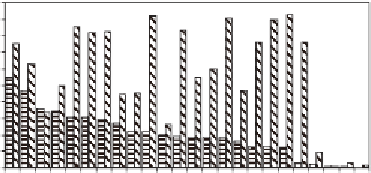Agriculture Reference
In-Depth Information
RFLP procedures are particularly useful for iden-
tifying species. Species-targeted real-time PCR
procedures have been developed to differentiate
and quantify
P. neglectus
and
P. thornei
in a single
DNA extract from soil (G.P. Yan and R.W.
Smiley, unpublished data).
Biological diversity among populations has
been reported for six
Pratylenchus
species (De
Waele and Elsen 2002), including
P. neglectus
on
potato (Hafez et al., 1999) but not for
P. thornei
.
The potential impact of
P. neglectus
heterogeneity
or pathotypes on wheat has not been reported, but
results from screening specifi c wheat and barley
genotypes against populations of both
P. neglectus
and
P. thornei
in Australia, Mexico, Turkey, and
the US have thus far been uniform for both
species across all countries, as have been observa-
tions from crop rotation experiments and com-
mercial practices.
polyphagous nature of
P. neglectus
and
P. thornei
.
The greatest long-term production effi ciency will
therefore be achieved with wheat cultivars that
are both resistant and tolerant to the most eco-
nomically important
Pratylenchus
species in a
region or to both species where mixtures occur
(Thompson et al., 2008; Vanstone et al., 2008).
However, cultivars with resistance to
P. neglectus
are not necessarily resistant to
P. thornei
(Fig. 8.3), and vice versa (Farsi et al., 1995).
50
45
40
35
30
25
20
15
10
5
0
Management
Management of root-lesion nematodes is best
approached by integrating crop rotations (Fig.
8.2) and planting wheat cultivars that are both
resistant (Fig. 8.3) and tolerant (Fig. 8.4). Rota-
tions alone are somewhat limited due to the
Fig. 8.3
Reproductive factor (Rf) for
Pratylenchus thornei
(left) and
P. neglectus
(right) in 20 Pacifi c Northwest (US)
winter wheat cultivars, in 3 lines carrying genes for resistance,
and in unplanted soil; Rf
=
P
f
P
i
−1
×
100, where P
f
=
fi nal
number after 16 weeks' growth and P
i
=
initial population in
soil (750 nematodes per kilogram).
4,000
y = 13,611 - 1,541.7x
R
2
= 0.94
P
< 0.0001
5
2
3,500
100
3,000
90
3,000
3
80
2,500
70
2,000
.
60
4
2,000
1
50
1,500
40
1,000
30
1,000
20
500
0
10
6
7
8
9
0
0
RLN: (ln+1)/kg soil
Fig. 8.2
Relationship between numbers of root-lesion nem-
atodes (RLN) and grain yield for winter wheat in fi ve crop-
rotation and tillage-management treatments in a 300-mm
precipitation zone of Oregon (US); means across 3 years for
no-till annual winter wheat (1), rotations of winter wheat with
cultivated fallow (2) or with chemical fallow (3), rotation of
no-till winter wheat and no-till winter pea (4), and rotation
of no-till winter wheat, no-till spring barley, and chemical
fallow (5).
Fig. 8.4
Tolerance index (bars) and grain yield for
Pacifi c Northwest (US) spring wheat cultivars produced in
untreated soil (
) or in soil treated with nematicide (
) to
reduce numbers of
Pratylenchus neglectus
; grain yield in
untreated soil correlated with tolerance index (R
2
=
0.80,
P
<
0.0001).
















































